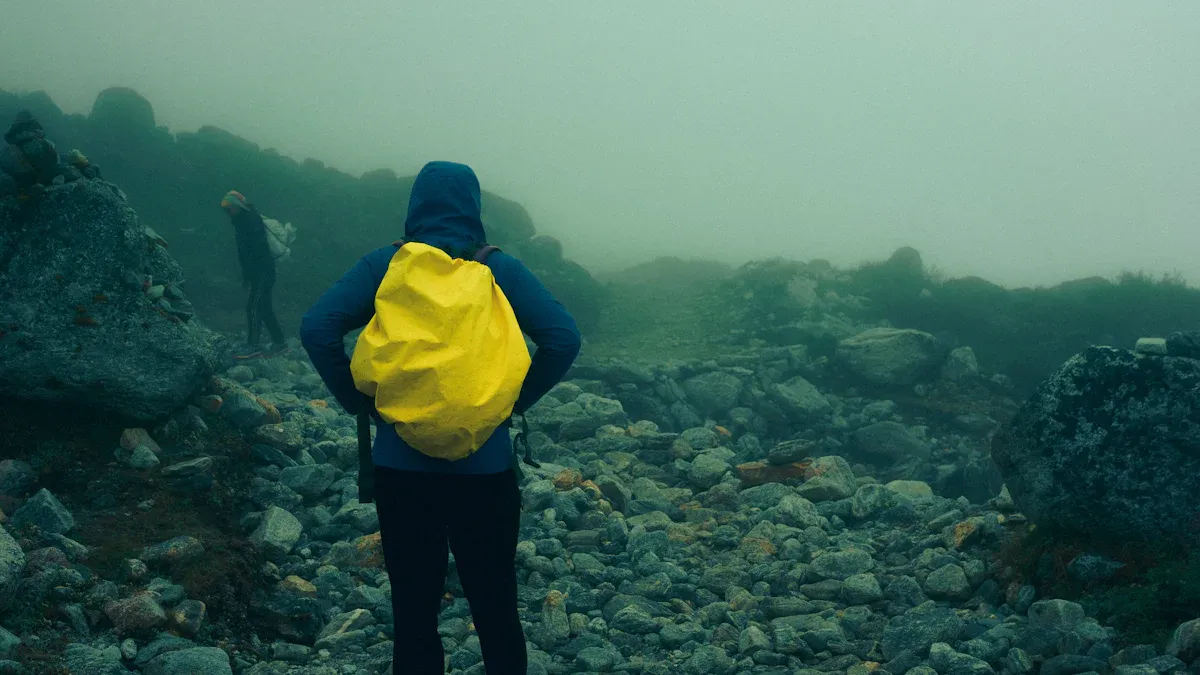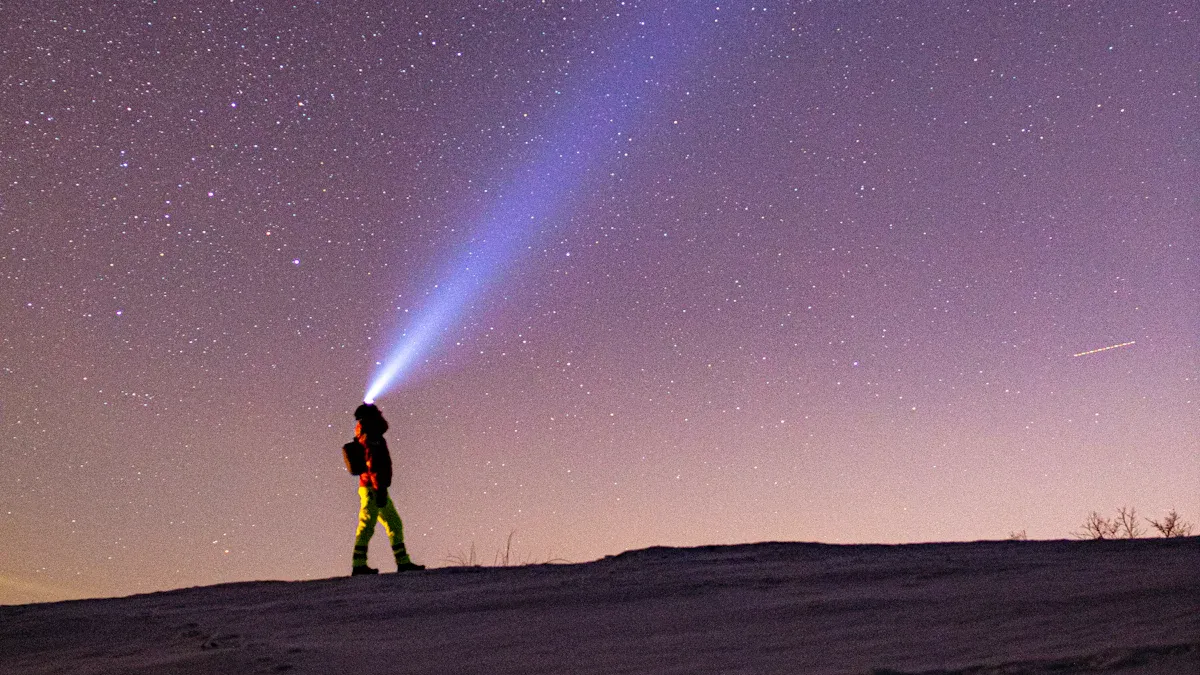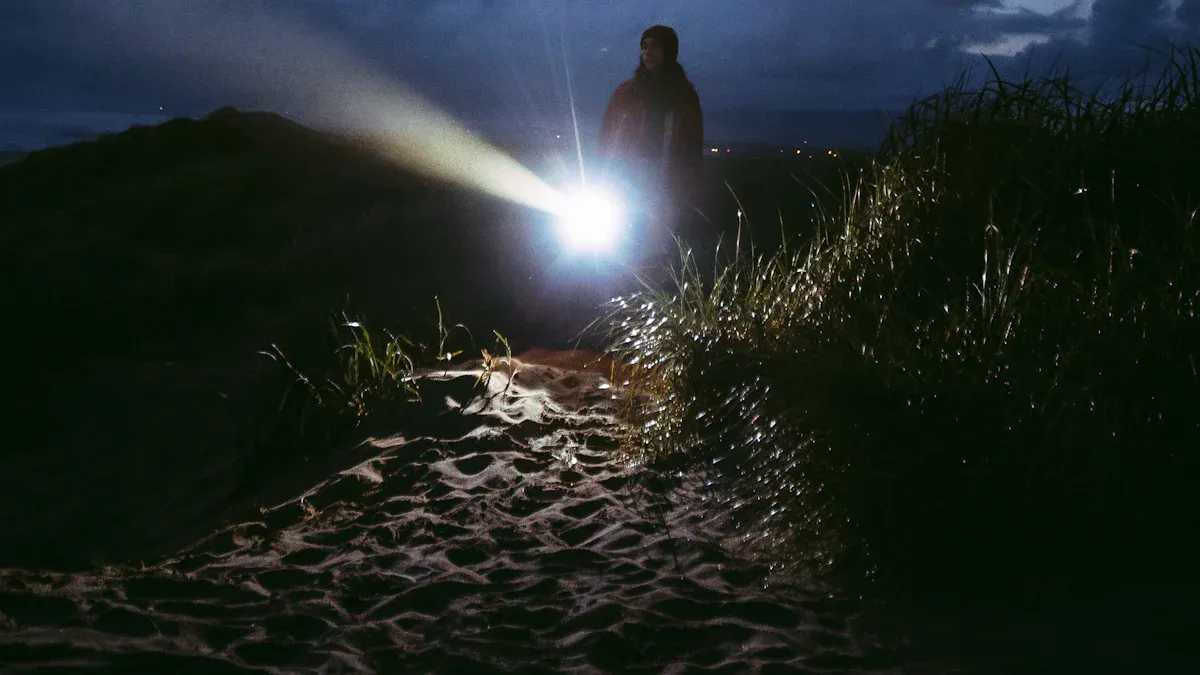How Flashlights Make Exploring the Outdoors Safer After Dark

Exploring the outdoors after dark can be thrilling, but it comes with risks. A flashlight becomes your best ally in these moments. It lights up rocky trails, helping you avoid tripping. It also guides you through dense forests by revealing trail markers. Whether setting up camp or signaling for help, it ensures you stay safe.
Key Takeaways
A flashlight helps you see better in the dark, making it important for safe hiking and camping.
Picking a good flashlight means checking brightness, beam range, and strength to match your outdoor plans.
Taking care of your flashlight and storing it properly makes it last longer and work well when needed.
Benefits of Using a Flashlight Outdoors

Enhancing Visibility in Low-Light Conditions
When you're out in the wilderness after sunset, a flashlight becomes your most essential gear. It helps you see clearly in low-light conditions, whether you're hiking, camping, or exploring. Modern flashlights often come with high lumen output, which provides excellent visibility even in the darkest environments. Some models also feature adjustable focus, allowing you to switch between a wide floodlight for close-up tasks and a spotlight for long-distance visibility.
Additionally, flashlights with red light modes are perfect for preserving your night vision, especially if you're stargazing or navigating trails. These features make a flashlight indispensable for enhancing visibility in low-light conditions, ensuring you can safely enjoy your outdoor activities.
Preventing Accidents and Ensuring Safety
A flashlight is more than just a tool for seeing in the dark—it’s a lifesaver. It helps you avoid common hazards like tripping over loose rocks or hidden roots while hiking on rocky or uneven trails. If you're camping in remote locations, a flashlight makes setting up your tent or cooking in the dark much safer.
In emergencies, a reliable flashlight can illuminate your surroundings and even signal for help using strobe or SOS modes. These features are crucial for outdoor safety, giving you peace of mind during your adventures. Whether you're navigating dense forests or unfamiliar terrain, a flashlight ensures you stay on the right path and avoid potential dangers.
Lighting the Path Ahead in Emergencies
Emergencies can happen when you least expect them, and having a flashlight on hand can make all the difference. Brightness levels of 300-500 lumens are ideal for hiking, while 1000+ lumens are perfect for search and rescue situations. Durable and weather-resistant flashlights are especially useful, as they can withstand harsh conditions without failing.
Flashlights with long beam distances are excellent for lighting the path ahead, helping you find your way back to safety. Whether you're lost in the woods or stranded on a deserted road, a flashlight can guide you and even attract the attention of rescuers. It’s an essential gear that no outdoor enthusiast should leave behind.
Choosing the Right Flashlight for Outdoor Adventures

Brightness and Beam Distance
When you're choosing a flashlight for outdoor adventures, brightness and beam distance are two of the most important factors to consider. Brightness, measured in lumens, determines how much light the flashlight emits. For most outdoor activities like hiking or camping, a flashlight with 200 to 400 lumens works well. If you're navigating challenging terrain or need to light up a larger area, you might want something with 1,000 lumens or more.
Beam distance, on the other hand, tells you how far the light can reach. A flashlight with a beam distance of 100 to 200 meters is ideal for activities like hiking or backpacking. Here's a quick guide to help you decide:
Lumens | Distance | Best For |
|---|---|---|
1–250 | Up to 80 meters | Everyday tasks or leisure activities |
160–400 | Up to 100 meters | Camping, hiking, backpacking |
400–1000 | Up to 200 meters | Caving, engine repair, or nighttime navigation |
1000–3000 | Up to 350 meters | Fishing, hunting, or rock climbing |
Understanding these metrics ensures you pick the right flashlight for your needs, whether you're exploring trails or trying to navigate the wilderness.
Durability and Weather Resistance
A high-quality flashlight should be tough enough to handle the outdoors. Look for models made from materials like high-grade aluminum or reinforced plastic. These materials resist wear and tear, making them perfect for rugged adventures. Flashlights with rubberized exteriors or O-ring seals are also great because they prevent water and dust from getting inside.
When it comes to weather resistance, check the flashlight's IP rating. For example, an IP67-rated flashlight can handle heavy rain and brief submersion, while an IP68-rated one can survive even harsher conditions. Some durable models, like the Olight Warrior X Pro, offer impact resistance up to three meters and perform well in extreme weather.
If you prefer hands-free options like headlamps, make sure they also meet these durability standards. A sturdy headlamp can be a lifesaver when you're setting up camp or navigating in the dark.
Battery Life and Power Options
Battery life is another critical factor when you're choosing a flashlight for outdoor adventures. Long-lasting batteries ensure your flashlight won't fail when you need it most. Rechargeable batteries are a popular choice because they're eco-friendly and cost-effective in the long run. Many modern flashlights come with built-in lithium-ion batteries that you can charge via USB, making them convenient for outdoor trips.
Rechargeable batteries also perform better in cold weather compared to disposable ones. If you're planning a longer trip, consider carrying a backup power bank to recharge your flashlight or headlamp. For lanterns, look for models with dual power options, like rechargeable batteries and disposable ones, to ensure you always have light when you need it.
By focusing on these three factors—brightness, durability, and battery life—you can confidently choose a flashlight that meets your outdoor needs. Whether you're using a lantern to light up your campsite or a headlamp for hands-free navigation, the right flashlight makes all the difference.
Tips for Using Flashlights Effectively
Adjusting Brightness for Optimal Visibility
Using the right brightness level can make your flashlight more effective in the wilderness. Many modern flashlights come with adjustable brightness modes, allowing you to tailor the light to your needs. For example, lower brightness settings are perfect for reading maps or conserving battery life, while higher settings are ideal for spotting hazards or signaling for help during emergencies.
Here’s a quick guide to help you choose the right brightness for different activities:
Lumens | Distance | Best For |
|---|---|---|
1–250 | Up to 80 meters | Everyday and leisure activities in dim conditions |
160–400 | Up to 100 meters | Camping, hiking, backpacking |
400–1000 | Up to 200 meters | Hiking, caving, campervan engine repair |
1000–3000 | Up to 350 meters | Fishing, hunting, rock climbing |
3000–7000 | Up to 500 meters | Emergency rescue, mountaineering |
By adjusting the brightness based on your activity, you can optimize visibility and extend battery life.
Maintaining and Storing Your Flashlight
Proper care ensures your flashlight stays reliable during outdoor adventures. Start by cleaning it regularly. Wipe the lens and handle with a microfiber cloth to remove dirt. Check the O-rings for wear and apply lubricant every six months to maintain waterproofing.
When storing your flashlight, keep it in a cool, dry place. Remove the batteries if you won’t use it for a while to prevent leakage. Use a battery storage container to keep spare batteries organized and safe. Regularly inspect your flashlight for damage or malfunctions, especially before heading into the wilderness.
Using Flashlights in Real-Life Scenarios
Flashlights are indispensable for adventurers in many situations. They illuminate your path, helping you avoid tripping over rocks or roots. If you’re camping, they make setting up tents or cooking in the dark much easier. In emergencies, flashlights are vital for signaling for help during emergencies or navigating back to safety.
For example, a group of hikers in the Appalachian Mountains once used their flashlight to find their way back after getting lost. The powerful beam helped them locate trail markers and signal a rescue helicopter. This shows how a flashlight can be a lifesaver in the wilderness.
A flashlight is more than just a tool—it’s your safety companion during nighttime adventures. It helps you avoid tripping hazards, spot obstacles, and navigate trails with confidence. Whether you’re lighting up the path or signaling for help, a flashlight ensures you’re prepared for the unexpected.
Choosing the right flashlight is equally important. Look for one that’s durable, has long battery life, and offers adjustable brightness. These features make it reliable for any outdoor activity, from hiking to camping.
Don’t underestimate the value of carrying a flashlight. It’s essential for lighting the path ahead and staying safe in unpredictable situations. Make it a priority to pack one for your next adventure—you’ll thank yourself later!
FAQ
What type of flashlight is best for camping?
Look for a durable flashlight with 200-400 lumens, weather resistance, and long battery life. A headlamp is also great for hands-free tasks.
How do you maintain a flashlight for outdoor use?
Clean the lens, check O-rings, and store it in a dry place. Remove batteries if unused for long periods to prevent leakage.
Can a flashlight help in emergencies?
Absolutely! Use strobe or SOS modes to signal for help. A bright flashlight can also guide rescuers or help you navigate back to safety.
See Also
Why Hunting Flashlights Are Crucial for Outdoor Adventures
Choosing Between Lanterns and Flashlights for Camping Trips
SF1 Flashlight: Brighten Up Your Camping Experiences
